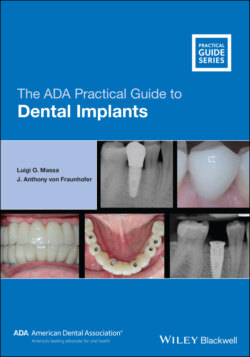Читать книгу The ADA Practical Guide to Dental Implants - J. Anthony von Fraunhofer - Страница 23
Endosseous Implants
ОглавлениеEndosseous implants, also known as intra‐osseous and endosteal implants, have been in clinical use since the 1960s [12]. There are four main categories of endosseous implant, namely pins, spirals, blades, and screws. Regardless of implant design, endosseous implants are used in edentulous areas where there is sufficient healthy bone to accommodate the implant. Selection criteria for the use of implants are discussed in later chapters of this book.
The first successful endosseous implants were the Formiggini spiral screw implant and, subsequently, the Cherchève spiral‐post implant, the former dating from 1947 and the latter from the 1960s to 1970 [4, 12]. The most sophisticated, and successful, Cherchève implant consisted of a double hollow spiral mounted on a square post. After the bone was trephined to create a cavity, the implant was placed beneath the alveolar ridge with the shank or post extending into the oral cavity and, upon which, the final prosthesis was constructed. The problem with these early implants was that trephining of the bone created a gap or space between the abutment post and the host hard and soft tissues, and this could sometimes present problems.
Many workers developed modifications of the spiral implant during the late 1960s and early 1970s. These largely comprised self‐tapping screw implants, often with a vent or port below the threaded portion to permit fibrous tissues and, hopefully, bone to grow through the aperture and promote retention. Although many of these screw implants were successful, numerous failures occurred as the result of tissue irritation, frank infection and epithelial downgrowth preventing adequate retention and sometimes complete evulsion of the implant. Commonly, poor bony attachment to these implants caused stability to be a problem.
An alternative approach to screw‐type endosseous implants was the tripodal pin concept which dated from the same period. In essence, thin tantalum pins were inserted into bone at roughly 120° angulations and the exposed ends of the pins were bonded together using acrylic resin, Fig. 2.2.
The implanted tripodal system could then be used as a bridge abutment or to support a single‐unit prosthesis. Although pin implants had certain applications, they did not possess long‐term retention, generally were not self‐supporting and the pins often were easily displaced or removed over time.
A major development in endosseous implants was the blade or blade vent implant designed by Linkow in 1968 and subsequently modified by Linkow and others over the period 1970–1971 [12–14]. Blade implants were originally designed for use in areas where there were knife‐edge alveolar ridges, situations where screw‐type implants are contra‐indicated. These implants can be used in virtually all maxillary and mandibular edentulous areas, provided there is sufficient residual alveolar process. Because the implants have greater mesio‐distal dimensions than their vertical heights, the design combines maximal stability, especially against lateral forces, while minimizing risk to underlying tissues and structures.
Figure 2.2 Schematic diagram of tripodal pin concept.
Clinically, bone often grew through the vents of the blade implants so that the early success rate was very high although the long‐term prognosis was lower, especially with maxillary placements. Various problems were associated with blade implants, particularly the difficulty in achieving an ideal gingival relationship with that crown when used to support a single crown. There were also problems with thin ridges such that any bony destruction could result in implant loss. Apparently, fewer problems were found with blades used to support a denture base although stability was a problem with unilateral mandibular free‐end saddles.
The modern “screw” implant derives from the pioneering work of Stefano Tramonte [15] in Italy and Per‐Ingvar Brånemark in Sweden [16, 17], both of whom advocated the use of titanium for dental implants.
The excellent physical properties and outstanding biocompatibility of titanium were the driving force for this application. In particular, Brånemark described the clinically observed close apposition and adherence of bone with titanium, which he termed osseointegration. Since then, a wide variety of “screw” or tooth root‐shaped endosseous implants have come into clinical use, Fig. 2.3 and Fig. 2.4 and they have achieved remarkable clinical success such that they are now considered important components of the restorative dentistry armamentarium. However, the clinical success of dental implants requires good clinical technique, accurate placement and careful patient selection with good bone quality (see later chapters in this book).
Figure 2.3 Different types of implants.
Figure 2.4 Modern screw‐type implant.
(Source: Courtesy of Biohorizons).
Of central importance for any metal within the oral cavity is corrosion resistance as well as mechanical strength. Consequently, the vast majority of modern dental implants are fabricated from titanium and its alloys, notably Ti‐6Al‐4V, the so‐called 6‐4 alloy, although CP (commercial purity) Titanium and alloys such as Ti‐13Cu‐4.5Ni have also been evaluated. Most implants are fabricated using powder metallurgy, typically hot isostatic pressing HIP technology.
The efficacy and rate of osseointegration of bone and implant has been enhanced by techniques such as designing the implant with a screw profile, providing a micro‐texture to the implant surface as well as coating the surface with hydroxyapatite (HA). More recently, a novel approach to dental implantology has been to coat the implant surface with a nanometer‐thick layer of protein containing a bisphosphonate drug. Animal studies indicate that the bone surrounding the implant becomes denser and stronger, ensuring a more durable implant‐tissue interface.
